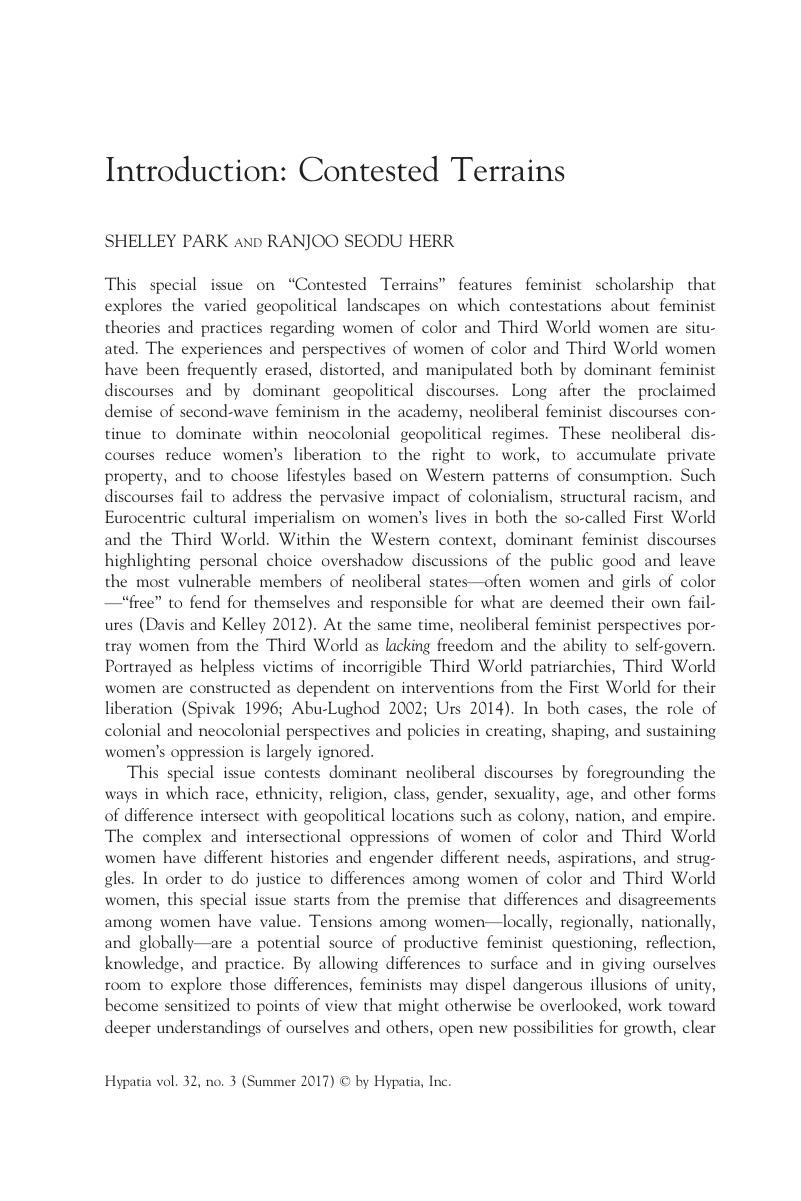No CrossRef data available.
Article contents
Introduction: Contested Terrains
Published online by Cambridge University Press: 01 January 2020
Abstract
An abstract is not available for this content so a preview has been provided. Please use the Get access link above for information on how to access this content.

Information
- Type
- Introduction
- Information
- Hypatia , Volume 32 , Issue 3: Special Issue: Contested Terrains: Women of Color and Third World Women, Feminisms, and Geopolitics , Summer 2017 , pp. 477 - 487
- Copyright
- Copyright © 2017 by Hypatia, Inc.
References
Abu‐Lughod, Lila. 2002. Do Muslim women really need saving? Anthropological reflections on cultural relativism and its others. American Anthropologist 104 (3): 78–90.CrossRefGoogle Scholar
Ahmed, Sara. 2006. Queer phenomenology: Orientations, objects, others. Durham, N.C.: Duke University Press.CrossRefGoogle Scholar
Barad, Karen. 2003. Posthumanist performativity: Toward an understanding of how matter comes to matter. Signs 28 (3): 801–31.CrossRefGoogle Scholar
Cho, Sumi, Crenshaw, Kimberlé, and McCall, Leslie. 2013. Toward a field of intersectionality studies: Theory, applications, and praxis. Signs 38 (4): 785–810.CrossRefGoogle Scholar
Collins, Patricia Hill. 2004. Black sexual politics: African Americans, gender, and the new racism. New York: Routledge.CrossRefGoogle Scholar
Crenshaw, Kimberlé. 1989. Demarginalizing the intersection of race and sex: A black feminist critique of antidiscrimination doctrine, feminist theory and antiracist politics. University of Chicago Legal Forum: Feminism in the Law: Theory Practice and Criticism (1) (1989): 139–67.Google Scholar
Crenshaw, Kimberlé. 1991. Mapping the margins: Intersectionality, identity politics, and violence against women of color. Stanford Law Review 43 (6): 1241–99.CrossRefGoogle Scholar
Davis, Angela Y., and Kelley, Robin D. G. 2012. The meaning of freedom: And other difficult dialogues. San Francisco: City Lights Publishers.Google Scholar
Dixon, Deborah P. 2015. Feminist geopolitics: Material states. Farnham, UK: Ashgate Publishing Limited.Google Scholar
Dixon, Deborah P., and Marston, Sallie A. 2011. Introduction: Feminist engagements with geopolitics. Gender, Place & Culture 18 (4): 445–53.CrossRefGoogle Scholar
Dowler, Lorraine, and Sharp, Joanne. 2001. A feminist geopolitics? Space & Polity 5 (3): 165–76.CrossRefGoogle Scholar
Fricker, Miranda. 2009. Epistemic injustice: Power and the ethics of knowing. New York: Oxford University Press.Google Scholar
Lowe, Lisa. 2015. The intimacies of four continents. Durham, N.C.: Duke University Press.CrossRefGoogle Scholar
Lugones, Maria. 2003. Pilgrimages/Peregrinajes: Theorizing coalition against multiple oppressions. Lanham, Md.: Rowman & Littlefield.Google Scholar
Medina, José. 2012. The epistemology of resistance: Gender and racial oppression, epistemic injustice, and resistant imaginations. New York: Oxford University Press.Google Scholar
Mohanty, Chandra Talpade. 2002. “Under Western eyes” revisited: Feminist solidarity through anticapitalist struggles. Signs 28 (2): 499–535.CrossRefGoogle Scholar
Pohlhaus, Gaile Jr. 2011. Wrongful requests and strategic refusals to understand. In Feminist epistemology and philosophy of science, ed. Grasswick, Heidi E.Dordrecht: Springer.Google Scholar
Puar, Jasbir. 2011. “I would rather be a cyborg than a goddess”: Intersectionality, assemblage, and affective politics. Transversal, January. http://eipcp.net/transversal/0811/puar/en (accessed April 20, 2017).Google Scholar
Spivak, Gayatri Chakravorty. 1996. The Spivak reader: Selected works of Gayatri Chakravorty Spivak, ed. MacLean, Gerald M. and Landry, Donna. New York: Routledge.Google Scholar
Sullivan, Shannon, and Tuana, Nancy, eds. 2007. Race and epistemologies of ignorance. Albany: State University of New York Press.Google Scholar
Urs, Tara. 2014. Coercive feminism. Columbia Human Rights Law Review 46 (1) (Fall): 85–157.Google Scholar

